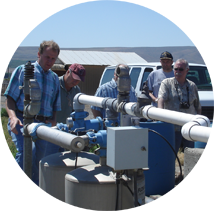Consumptive Use and Irrigation Water Requirements Estimates for Washington
We tried to estimate the consumptive use (evapotranspiration or ET) of various crops grown in various parts of the state. We did this by taking 30 years of historical weather data from different weather stations located around the state. We used that to calculate how much water a reference crop of alfalfa would need (ETr) on each day at each of these many different weather stations. We had to estimate missing data in some instances, but we most often just left bad data points out to make averages from slightly fewer than 30 years.
The mean ETr for every station for each day of the year can be multiplied by a crop coefficient (Kc) that is specific to a particular crop and that crop's growth stage to give an estimate of the ET of that particular crop (ETc). This can be expressed as ETc = Kc * ETr. Effective precipitation (Pe) was calculated following NRCS here, and an assumed 2 inch soil water storage. The equation is Pe = 0.921719*(0.70917*Pt^0.82416-0.11556)*10^(0.02426*ETc) using monthly total total precipitation (Pt) and crop ET (ETc) values.
Crop coefficients have to be developed by accurately measuring actual crop water use. Measuring actual ET is very expensive and time consuming to do properly. Because of this there are not good crop coefficients available for many crops. This is particularly true for the very wide variety of specialty crops grown in Washington State.
Crop coefficients change over time with the different crop growth stages. These curves can be approximated many different ways. Although many are just defined using a series of points at different days of year (DOY) and straight line interpolation between these points, these curves don't transfer well accross the diversity of climates that we have in Washington State. Planting, maturation, and harvest dates vary widely accross the state for example. Growing degree days (GDD) are a good way to approximate crop developmental stages under varying climates. They are based on how much cumulative heat the plants have been exposed to in the season. We converted these crop coefficients to work with growing degree days.
These methods are not perfect and are approximations of crop water use for the average year. And of course no year is average. Some years the crops need more water and some years they need less water. My best guestimate of the accuracy of the ETr estimates, based on weather stations that were near each other that should have been equivalent, but were not, is that these estimates are plus or minus about 10 to 15%. There is a lot of variability and uncertainty in crop coefficients as well.
We wrote a report on the sources of data, and the methods we used to clean, and calculate the data are summarized in this report.
Historic Mean Water Needs Estimate. Using Constant Days of Year (DOY).
Uses Crop Coeffcients at 21 Predefined Days of Year, and Linear Interpolation for the Chosen Crop Grown in Eastern Washington. Go here for more information.
Historic Mean Water Needs Estimate. Using Growing Degree Days (GDD).
Uses Crop Coeffcients at 21 Growing Degree Day (GDD) that define the Growth Stage, and Linear Interpolation for the chosen Crop Grown in Eastern Washington.
Historic Mean Water Needs Estimate. Using 5 Points as in the FAO56 report.
Uses Crop Coefficients based on 5 Days of Year and Linear Interpolation for Eastern Washington. These crop coefficients are the defaults used in the irrigation scheduler and were largely approximated from the Agrimet, 21 point crop coefficients.
All Crops at One Station
Calculates and displays the Annual Total Mean ETr, Pt, ETc, and IWR for All Crops for the Chosen Station. This uses the 21 point crop coefficients that are based on Day of Year like this page. Because of this, these numbers are most applicable to the Columbia Basin.
All Stations for One Crop
Calculates and displays the annual total mean ETr, Pt, ETc, and IWR for All Stations for the Chosen Crop. This uses the 21 point crop coefficients that are based on Day of Year like this page. Because of this, these numbers are most applicable to the Columbia Basin.
